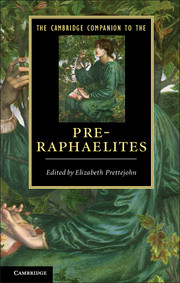Book contents
- Frontmatter
- Introduction
- PART ONE PRE-RAPHAELITISM
- PART TWO PRE-RAPHAELITES
- 6 The poetry of Dante Gabriel Rossetti (1828–1882)
- 7 The painting of Dante Gabriel Rossetti
- 8 William Holman Hunt (1827–1910)
- 9 John Everett Millais (1829–1896)
- 10 Ford Madox Brown (1821–1893)
- 11 Christina Rossetti (1830–1894)
- 12 Elizabeth Eleanor Siddall (1829–1862)
- 13 The writings of William Morris (1834–1896)
- 14 The designs of William Morris
- 15 Edward Burne-Jones (1833–1898)
- 16 Algernon Charles Swinburne (1837–1909)
- 17 William Michael Rossetti (1829–1919)
- 18 Envoi
- Appendix 1 The contents of The Germ
- Appendix 2 The Pre-Raphaelite ‘list of Immortals’
- Guide to further reading and looking
- Cambridge Companions to …
- Index
7 - The painting of Dante Gabriel Rossetti
from PART TWO - PRE-RAPHAELITES
Published online by Cambridge University Press: 28 September 2012
- Frontmatter
- Introduction
- PART ONE PRE-RAPHAELITISM
- PART TWO PRE-RAPHAELITES
- 6 The poetry of Dante Gabriel Rossetti (1828–1882)
- 7 The painting of Dante Gabriel Rossetti
- 8 William Holman Hunt (1827–1910)
- 9 John Everett Millais (1829–1896)
- 10 Ford Madox Brown (1821–1893)
- 11 Christina Rossetti (1830–1894)
- 12 Elizabeth Eleanor Siddall (1829–1862)
- 13 The writings of William Morris (1834–1896)
- 14 The designs of William Morris
- 15 Edward Burne-Jones (1833–1898)
- 16 Algernon Charles Swinburne (1837–1909)
- 17 William Michael Rossetti (1829–1919)
- 18 Envoi
- Appendix 1 The contents of The Germ
- Appendix 2 The Pre-Raphaelite ‘list of Immortals’
- Guide to further reading and looking
- Cambridge Companions to …
- Index
Summary
In his memoir of his brother, William Michael Rossetti described the drawing of 1849, The First Anniversary of the Death of Beatrice (Figure 2), as ‘more decidedly marked by the “Praeraphaelite” peculiarities of that date than anything else which Rossetti produced’. What did William mean by this? The drawing is one of the very few works by members of the Brotherhood that include the ‘P. R. B.’ initials appended to the signature, and in the top right corner, outside the line that encloses the image, an inscription reads ‘Dante G. Rossetti / to his P R Brother / John E. Millais’. On the literal level, then, the drawing is a Pre-Raphaelite artefact – not just a document of the friendships among the Brothers in the early days of their association, but a physical object handed from one Brother to another and invested with visible and legible signs of their collaboration within the wider Brotherhood.
On a second level, the image is ‘Pre-Raphaelite’ in subject and setting: it represents the early Italian poet Dante with a group of his friends, and another inscription marks the place and date, ‘Florence, 9th June, 1291’. This seems to be the first time Rossetti represented a scene from Dante's story of his early life, the Vita Nuova, which he had just translated into English; the drawing makes a second translation, this time from word to image. By selecting the episode where Dante makes a drawing of an angel, on the first anniversary of Beatrice’s death, Rossetti marks the transition from verbal to visual expression in his own exploration of Dante’s art. At the same time, he gives the earlier poet a role, indeed a founding role (given the early date of the event), in the history of Italian visual art, as well as literature.
- Type
- Chapter
- Information
- The Cambridge Companion to the Pre-Raphaelites , pp. 103 - 115Publisher: Cambridge University PressPrint publication year: 2012

